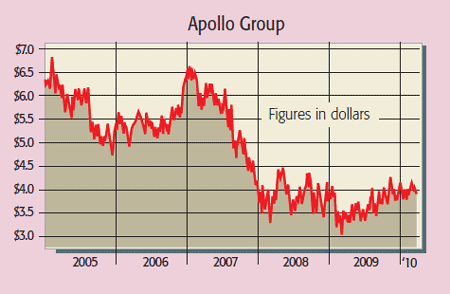
They’ve been growing at doubledigit rates for years. They didn’t so much weather the recession as thrive on it, with new business up 20%-50% last year. Yet they trade on estimated price/earnings (p/e) ratios of just ten to twelve times. What do investors have against companies in America’s for-profit education sector? Few education topics provoke such strong reactions as the idea of companies making profits from running universities and colleges.
Fans see these firms adding a healthy injection of market forces into a field dominated by inefficient, non-profit public institutions that are failing to provide what students want in a way that’s convenient to them. That’s why enrolments at Apollo Group’s University of Phoenix – which teaches degree courses online and at small local campuses around the country – have risen from 100,000 to 400,000 over the past decade.
But critics accuse them of being ‘diploma mills’, taking students’ money for qualifications that have no academic rigour and little value for jobseekers. And while it’s hard to say which view is more widespread, there’s no doubt the detractors are getting heard more often. So Apollo and its peers, such as DeVry, ITT Educational Services and Strayer Education, have a growing PR problem.
Some of the criticism may be overdone. Sure, there are plenty of dodgy outfits in the industry. But big brand firms, such as Apollo, are not offering degrees within days, as some do – ‘based on your life experience and prior learning’. And most students surely know that an MBA from the University of Phoenix is not the equivalent of one from a top business school. Although many recruiters are wary of degrees from for-profit schools, within technical and vocational subjects it’s possible to find plenty of people who praise the quality of their private courses. Still, it was only a matter of time before the industry came under scrutiny, given its dependence on the state’s largesse.
Almost all for-profits firms get a majority of their revenue from grants and students loans that are underwritten by the US government. Accusations that for-profits cost more than public colleges, while having higher drop-out rates and higher default rates on loans, are gaining traction. By themselves, statistics like these can be challenged: the for-profits claim they cater to people ill-served by traditional institutions, such as low-income and mature students, who will behave differently to students at public universities.
But there are no shortage of other semi-scandals to support the case for a clampdown. For example, legally, for-profits must get no more than 90% of their revenues from federal programmes.
With many companies close to this barrier, there’s a risk of unethical behaviour to stay on the right side of the divide. The SEC has investigated various firms for revenue recognition issues, but without charges following so far. Meanwhile, a heavy push into recruiting students from the US military is partly driven by the fact that government funding via the military doesn’t count towards this gap. Companies are alleged to have encouraged recruiters to be overly aggressive in signing up these students. Most of these criticisms aren’t new.
But the Obama administration seems more likely to act on them and tougher regulation looks likely. However, while this will hurt short-term margins and growth, it could well be beneficial in the long run for the bigger players – they may be forced to purge dodgier practices, but equally, smaller firms may find it harder to compete. Investors should run an eye over the sector while it remains out of favour.
The best bet in the sector
Apollo Group (NYSE:APOL) is the largest for-profit education firm. It recently bought professional training firm BPP (the only UK for-profit business college that is currently allowed to award degrees) and plans to enlarge its MBA enrolment substantially.
However, despite its international aspirations, it will remain dependent on the US market for a long time. It’s also one of the firms currently the subject of an informal SEC enquiry. But barring disaster here, its healthy balance sheet and excellent margins mean it should survive and, ultimately, prosper from any industry shake-up. The shares look cheap on a p/e of 10.5 times estimated earnings.
Kaplan, the number-two provider, is the largest part of the Washington Post media group (NYSE:WPO). It could be worth as much alone as the whole firm’s current capitalisation. Relatively illiquid and controlled by the Graham family, the Post gets little coverage relative to its $4.5bn market cap, but also includes profitableTV operations, as well as the loss-making eponymous newspaper.
A p/e of 45 times last year’s earnings includes many exceptional items – the real valuation is probably closer to 15 times.That compares well with UK education and media group Pearson on 19. It also pays a dividend, with the current yield around 2%.